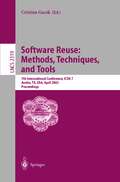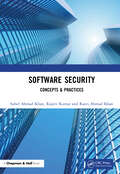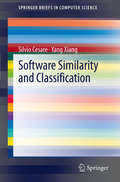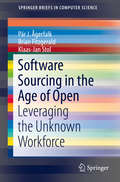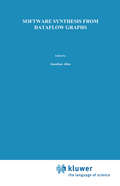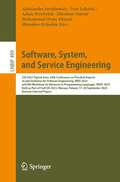- Table View
- List View
Software Reuse: 6th International Conference, ICSR-6 Vienna, Austria, June 27-29, 2000 Proceedings (Lecture Notes in Computer Science #1844)
by William B. FrakesThis book constitutes the refereed proceedings of the 6th International Conference on Software Reuse, ICSR-6, held in Vienna, Austria, in June 2000.The 26 revised full papers presented were carefully reviewed and selected from numerous submissions. The book is divided into topical sections on generative reuse and formal description languages, object-oriented methods, product line architectures, requirements reuse and business modeling, components and libraries, and design patterns.
Software Reuse: 7th International Conference, ICSR-7, Austin, TX, USA, April 15-19, 2002. Proceedings (Lecture Notes in Computer Science #2319)
by Cristina GacekAs a result of the open-source movement there is now a great deal of reusable software available in the public domain. This offers significant functionality that commercial software vendors can use in their software projects. Open-source approaches to software development have illustrated that complex, mission critical software can be developed by distributed teams of developers sharing a common goal. Commercial software vendors have an opportunity to both learn from the op- source community as well as leverage that knowledge for the benefit of its commercial clients. Nonetheless, the open-source movement is a diverse collection of ideas, knowledge, techniques, and solutions. As a result, it is far from clear how these approaches should be applied to commercial software engineering. This paper has looked at many of the dimensions of the open-source movement, and provided an analysis of the different opportunities available to commercial software vendors. References and Notes 1. It can be argued that the open-source community has produced really only two essential 9 products -- Apache (undeniably the most popular web server) and Linux although both are essentially reincarnations of prior systems. Both are also somewhat products of their times: Apache filled a hole in the then emerging Web, at a time no platform vendor really knew how to step in, and Linux filled a hole in the fragmented Unix market, colored by the community s general anger against Microsoft. 2.Evans Marketing Services, Linux Developers Survey, Volume 1, March 2000.
Software Reuse: Guidelines and Methods (Software Science and Engineering)
by James W. Hooper Rowena O. ChesterObservers in the present usually have an advantage when it comes to interpreting events of the past. In the case of software reuse, how ever, it is unclear why an idea that has gained such universal accep tance was the source of swirling controversy when it began to be taken seriously by the software engineering community in the mid-1980's. From a purely conceptual point of view, the reuse of software de signs and components promises nearly risk-free benefits to the devel oper. Virtually every model of software cost and development effort predicts first-order dependencies on either products size or the num ber of steps carried out in development. Reduce the amount of new product to be developed and the cost of producing the product de creases. Remove development steps, and total effort is reduced. By reusing previously developed engineering products the amount of new product and the number of development steps can be reduced. In this way, reuse clearly has a major influence on reducing total development cost and effort. This, of course, raises the issue of from whence the reused products arise. There has to be a prior investment in creating "libraries of reuse products before reuse can be successfuL . . " How can organizations with a "bottom line" orientation be enticed into contributing to a reuse venture? Fortunately, the economics of reuse l resembles many other financial investment situations .
Software Reuse: 15th International Conference, ICSR 2016, Limassol, Cyprus, June 5-7, 2016, Proceedings (Lecture Notes in Computer Science #9679)
by Georgia M. Kapitsaki Eduardo Santana de AlmeidaThis book constitutes the refereed proceedings of the 15th International Conference on Software Reuse, ICSR 2016, held in Limassol, Cyprus, in June 2016.The 21 revised full papers presented together with 4 revised short papers were carefully reviewed and selected from 51 submissions. The papers cover different areas of software engineering, where software reuse plays an important role, such as software product lines, domain analysis and modeling, software tools and business aspects of software. ICSR 2016 has provided a complete view on the advancements in the area of software reuse in the last years for interested researchers and practitioners.
Software Reuse for Dynamic Systems in the Cloud and Beyond: 14th International Conference on Software Reuse, ICSR 2015, Miami, FL, USA, January 4-6, 2015. Proceedings (Lecture Notes in Computer Science #8919)
by Ina Schaefer Ioannis StamelosThis book constitutes the refereed proceedings of the 14th International Conference on Software Reuse for Dynamic Systems in the Cloud and Beyond, ICSR 2015, held in Miami, FL, USA, in January 2015. The 21 revised full papers presented together with 3 revised short papers were carefully reviewed and selected from 60 submissions. The papers cover several software engineering areas where software reuse is important, such as software product lines, domain analysis, open source, components, cloud, quality.
Software Reuse: 8th International Conference, ICSR 2004, Madrid, Spain, July 5-9, 2004, Proceedings (Lecture Notes in Computer Science #3107)
by Jan Bosch Charles KruegerSoftware-Schutz: Rechtliche, organisatorische und technische Maßnahmen (Springers Angewandte Informatik)
by E. Piller A. WeissenbrunnerSoftware Security: Concepts & Practices
by Suhel Ahmad Khan Rajeev Kumar Raees Ahmad KhanSoftware Security: Concepts & Practices is designed as a textbook and explores fundamental security theories that govern common software security technical issues. It focuses on the practical programming materials that will teach readers how to implement security solutions using the most popular software packages. It’s not limited to any specific cybersecurity subtopics and the chapters touch upon a wide range of cybersecurity domains, ranging from malware to biometrics and more. Features The book presents the implementation of a unique socio-technical solution for real-time cybersecurity awareness. It provides comprehensible knowledge about security, risk, protection, estimation, knowledge and governance. Various emerging standards, models, metrics, continuous updates and tools are described to understand security principals and mitigation mechanism for higher security. The book also explores common vulnerabilities plaguing today's web applications. The book is aimed primarily at advanced undergraduates and graduates studying computer science, artificial intelligence and information technology. Researchers and professionals will also find this book useful.
Software Security: Concepts & Practices
by Suhel Ahmad Khan Rajeev Kumar Raees Ahmad KhanSoftware Security: Concepts & Practices is designed as a textbook and explores fundamental security theories that govern common software security technical issues. It focuses on the practical programming materials that will teach readers how to implement security solutions using the most popular software packages. It’s not limited to any specific cybersecurity subtopics and the chapters touch upon a wide range of cybersecurity domains, ranging from malware to biometrics and more. Features The book presents the implementation of a unique socio-technical solution for real-time cybersecurity awareness. It provides comprehensible knowledge about security, risk, protection, estimation, knowledge and governance. Various emerging standards, models, metrics, continuous updates and tools are described to understand security principals and mitigation mechanism for higher security. The book also explores common vulnerabilities plaguing today's web applications. The book is aimed primarily at advanced undergraduates and graduates studying computer science, artificial intelligence and information technology. Researchers and professionals will also find this book useful.
Software Security - Theories and Systems: Second Mext-WSF-JSPS International Symposium, ISSS 2003, Tokyo, Japan, November 4-6, 2003 (Lecture Notes in Computer Science #3233)
by Kokichi Futatsugi Fumio Mizoguchi Naoki YonezakiFollowing the success of the International Symposium on Software Security 2002 (ISSS 2002), held in Keio University, Tokyo, November, 2002, ISSS 2003 was held in the Tokyo Institute of Technology, Tokyo, on November 4–6, 2003. This volume is the collection of the papers that were presented at ISSS 2003. The proceedings of ISSS 2002 was published as LNCS 2609. Although the security and reliability of software systems for networked c- puter systems are major concerns of current society, the technology for software securitystillneedstobedevelopedinmanydirections.SimilartoISSS2002,ISSS 2003 aimed to provide a forum for research discussions and exchanges among world-leading scientists in the ?elds of both theoretical and systems aspects of security in software construction. The program of ISSS 2003 was a combination of invited talks and selected research contributions. It included the most recent visions and researches of the 9invitedspeakers,aswellas11contributionsofresearchesfundedbytheMEXT grant-in-aid for scienti?c research on the priority area “Implementation Scheme for Secure Computing” (AnZenKaken). We collected the original contributions after their presentation at the symposium and began a review procedure that resulted in the selection of the papers in this volume. They appear here in ?nal form. ISSS 2003 required a lot of work that was heavily dependent on members of the program committee, and sta?s and graduate students who participated in AnZenKaken. We sincerely thank them for their e?orts and time.
Software Security -- Theories and Systems: Mext-NSF-JSPS International Symposium, ISSS 2002, Tokyo, Japan, November 8-10, 2002, Revised Papers (Lecture Notes in Computer Science #2609)
by Mitsuhiro Okada Benjamin Pierce Andre Scedrov Hideyuki Tokuda Akinori YonezawaFor more than the last three decades, the security of software systems has been an important area of computer science, yet it is a rather recent general recognition that technologies for software security are highly needed. This book assesses the state of the art in software and systems security by presenting a carefully arranged selection of revised invited and reviewed papers. It covers basic aspects and recently developed topics such as security of pervasive computing, peer-to-peer systems and autonomous distributed agents, secure software circulation, compilers for fail-safe C language, construction of secure mail systems, type systems and multiset rewriting systems for security protocols, and privacy issues as well.
Software Service and Application Engineering: Essays Dedicated to Bernd Krämer on the Occasion of His 65th Birthday (Lecture Notes in Computer Science #7365)
by Maritta HeiselThis festschrift volume, published in honor of Bernd Krämer on the occasion of his 65th birthday, contains 11 contributions by close scientific companions. Covering topics like Petri nets and theoretical computer science, software and service engineering, cloud computing, and e-learning, the articles presented span the range of the scientific work of Bernd Krämer.
Software, Services, and Systems: Essays Dedicated to Martin Wirsing on the Occasion of His Retirement from the Chair of Programming and Software Engineering (Lecture Notes in Computer Science #8950)
by Rocco De Nicola Rolf HennickerThis book is dedicated to Professor Martin Wirsing on the occasion of his emeritation from Ludwig-Maximilians-Universität in Munich, Germany. The volume is a reflection, with gratitude and admiration, on Professor Wirsing’s life highly creative, remarkably fruitful and intellectually generous life. It also gives a snapshot of the research ideas that in many cases have been deeply influenced by Professor Wirsing’s work.The book consists of six sections. The first section contains personal remembrances and expressions of gratitude from friends of Professor Wirsing. The remaining five sections consist of groups of scientific papers written by colleagues and collaborators of Professor Wirsing, which have been grouped and ordered according to his scientific evolution. More specifically, the papers are concerned with logical and algebraic foundations; algebraic specifications, institutions and rewriting; foundations of software engineering; service oriented systems; and adaptive and autonomic systems.
Software Services for e-Business and e-Society: 9th IFIP WG 6.1 Conference on e-Business, e-Services and e-Society, I3E 2009, Nancy, France, September 23-25, 2009, Proceedings (IFIP Advances in Information and Communication Technology #305)
by Norbert Gronau Sushil Sharma Gérôme Canals Claude GodartI3E 2009 was held in Nancy, France, during September 23–25, hosted by Nancy University and INRIA Grand-Est at LORIA. The conference provided scientists andpractitionersofacademia,industryandgovernmentwithaforumwherethey presented their latest ?ndings concerning application of e-business, e-services and e-society, and the underlying technology to support these applications. The 9th IFIP Conference on e-Business, e-Services and e-Society, sponsored by IFIP WG 6.1. of Technical Committees TC6 in cooperation with TC11, and TC8 represents the continuation of previous events held in Zurich (Switzerland) in 2001, Lisbon (Portugal) in 2002, Sao Paulo (Brazil) in 2003, Toulouse (France) in 2004, Poznan (Poland) in 2005, Turku (Finland) in 2006, Wuhan (China) in 2007 and Tokyo (Japan) in 2008. The call for papers attracted papers from 31 countries from the ?ve con- nents. As a result, the I3E 2009 programo?ered 12 sessions of full-paper pres- tations. The 31 selected papers cover a wide and important variety of issues in e-Business,e-servicesande-society,including security,trust,andprivacy,ethical and societal issues, business organization, provision of services as software and software as services, and others. Extended versions of selected papers submitted to I3E 2009 will be published in the International Journal of e-Adoption and in AIS Transactions on Enterprise Systems. In addition, a 500-euros prize was awarded to the authors of the best paper selected by the Program Comm- tee. We thank all authors who submitted their papers, the Program Committee members and external reviewers for their excellent work.
Software Services for e-World: 10th IFIP WG 6.11 Conference on e-Business, e-Services, and e-Society, I3E 2010, Buenos Aires, Argentina, November 3-5, 2010, Proceedings (IFIP Advances in Information and Communication Technology #341)
by Wojciech Cellary Elsa Estevezth I3E 2010 marked the 10 anniversary of the IFIP Conference on e-Business, e- Services, and e-Society, continuing a tradition that was invented in 1998 during the International Conference on Trends in Electronic Commerce, TrEC 1998, in Hamburg (Germany). Three years later the inaugural I3E 2001 conference was held in Zurich (Switzerland). Since then I3E has made its journey through the world: 2002 Lisbon (Portugal), 2003 Sao Paulo (Brazil), 2004 Toulouse (France), 2005 Poznan (Poland), 2006 Turku (Finland), 2007 Wuhan (China), 2008 Tokyo (Japan), and 2009 Nancy (France). I3E 2010 took place in Buenos Aires (Argentina) November 3–5, 2010. Known as “The Pearl” of South America, Buenos Aires is a cosmopolitan, colorful, and vibrant city, surprising its visitors with a vast variety of cultural and artistic performances, European architecture, and the passion for tango, coffee places, and football disc- sions. A cultural reference in Latin America, the city hosts 140 museums, 300 theaters, and 27 public libraries including the National Library. It is also the main educational center in Argentina and home of renowned universities including the U- versity of Buenos Aires, created in 1821. Besides location, the timing of I3E 2010 is th also significant––it coincided with the 200 anniversary celebration of the first local government in Argentina.
Software Similarity and Classification (SpringerBriefs in Computer Science)
by Silvio Cesare Yang XiangSoftware similarity and classification is an emerging topic with wide applications. It is applicable to the areas of malware detection, software theft detection, plagiarism detection, and software clone detection. Extracting program features, processing those features into suitable representations, and constructing distance metrics to define similarity and dissimilarity are the key methods to identify software variants, clones, derivatives, and classes of software. Software Similarity and Classification reviews the literature of those core concepts, in addition to relevant literature in each application and demonstrates that considering these applied problems as a similarity and classification problem enables techniques to be shared between areas. Additionally, the authors present in-depth case studies using the software similarity and classification techniques developed throughout the book.
Software Sizing, Estimation, and Risk Management: When Performance is Measured Performance Improves
by Daniel D. Galorath Michael W. EvansTo achieve consistent software project success under the pressures of today's software development environment, software organizations require achievable plans including viable estimates of schedule, resources, and risks. To estimate realistically, you must understand how to apply sound estimation processes, tools, and data. Software Sizing
Software Sourcing in the Age of Open: Leveraging the Unknown Workforce (SpringerBriefs in Computer Science)
by Pär J. Ågerfalk Brian Fitzgerald Klaas-Jan StolThis SpringerBrief discusses multiple forms of open-source-inspired outsourcing: opensourcing, innersourcing and crowdsourcing. It uses a framework-based comparison to explain the strengths and weaknesses of each approach. By pointing out characteristics along with benefits and pitfalls of each approach, the authors provide nuanced and research-based advice to managers and developers facing software sourcing decisions. The differences and commonalities of these three emerging approaches are carefully analyzed. Chapters explore the primary challenges of reliability, efficiency and robustness in open-source methods. Examples from industrial cases are included, along with extensive references to recent research. The brief concludes with a comparative analysis of approaches and outlines key implications to be aware of when outsourcing. Software Sourcing in the Age of Open: Leveraging the Unknown Workforce is designed for professionals and researchers interested in outsourcing challenges. The content is also suitable for postgraduate students interested in contemporary software sourcing approaches.
Software Specification and Design: An Engineering Approach
by Ph.D., John MunsonThe rigors of engineering must soon be applied to the software development process, or the complexities of new systems will initiate the collapse of companies that attempt to produce them. Software Specification and Design: An Engineering Approach offers a foundation for rigorously engineered software. It provides a clear vision of what occurs at e
Software Specification Methods: An Overview Using a Case Study (Formal Approaches to Computing and Information Technology (FACIT))
by Marc Frappier Henri HabriasSoftware Specification Methods provides the formal methods practitioner with a survey of the key software specification methods. Each technique is demonstrated using the same case study, an invoicing system, to enable the reader to compare and contrast easily. Among the techniques covered are: UML; Z; SAZ; B; JSD; OMT; VHDL; Estelle; SDL; LOTOS. This book is intended for industrial and commercial practitioners who need to expand their knowledge of software specification methods. This book provides a basic overview of the main methods, with a practical focus which allows readers to apply their knowledge to real-life situations.
Software Specification Methods: An Overview Using A Case Study (Formal Approaches To Computing And Information Technology (facit) Ser.)
by Henri Habrias Marc FrappierThis title provides a clear overview of the main methods, and has a practical focus that allows the reader to apply their knowledge to real-life situations. The following are just some of the techniques covered: UML, Z, TLA+, SAZ, B, OMT, VHDL, Estelle, SDL and LOTOS.
Software Specification Methods
by Henri Habrias Marc FrappierThis title provides a clear overview of the main methods, and has a practical focus that allows the reader to apply their knowledge to real-life situations. The following are just some of the techniques covered: UML, Z, TLA+, SAZ, B, OMT, VHDL, Estelle, SDL and LOTOS.
Software Sustainability
by Coral Calero Mª Ángeles Moraga Mario PiattiniThis book focuses on software sustainability, regarded in terms of how software is or can be developed while taking into consideration environmental, social, and economic dimensions. The sixteen chapters cover various related issues ranging from technical aspects like energy-efficient programming techniques, formal proposals related to energy efficiency measurement, patterns to build energy-efficient software, the role of developers on energy efficient software systems and tools for detecting and refactoring code smells/energy bugs; to human aspects like its impact on software sustainability or the adaptation of ACM/IEEE guidelines for student and professional education and; and an economics-driven architectural evaluation for sustainability. Also aspects as the elements of governance and management that organizations should consider when implementing, assessing and improving Green IT or the relationship between software sustainability and the Corporate Social Responsibility of software companies are included. The chapters are complemented by usage scenarios and experience reports on several domains as cloud applications, agile development or e-Health, among others. As a whole, the chapters provide a complete overview of the various issues related to sustainable software development. The target readership for this book includes CxOs, (e.g. Chief Information Officers, Chief Executive Officers, Chief Technology Officers, etc.) software developers, software managers, auditors, business owners, and quality professionals. It is also intended for students of software engineering and information systems, and software researchers who want to know the state of the art regarding software sustainability.
Software Synthesis from Dataflow Graphs (The Springer International Series in Engineering and Computer Science #360)
by Shuvra S. Bhattacharyya Praveen K. Murthy Edward A. LeeSoftware Synthesis from Dataflow Graphs addresses the problem of generating efficient software implementations from applications specified as synchronous dataflow graphs for programmable digital signal processors (DSPs) used in embedded real- time systems. The advent of high-speed graphics workstations has made feasible the use of graphical block diagram programming environments by designers of signal processing systems. A particular subset of dataflow, called Synchronous Dataflow (SDF), has proven efficient for representing a wide class of unirate and multirate signal processing algorithms, and has been used as the basis for numerous DSP block diagram-based programming environments such as the Signal Processing Workstation from Cadence Design Systems, Inc., COSSAP from Synopsys® (both commercial tools), and the Ptolemy environment from the University of California at Berkeley. A key property of the SDF model is that static schedules can be determined at compile time. This removes the overhead of dynamic scheduling and is thus useful for real-time DSP programs where throughput requirements are often severe. Another constraint that programmable DSPs for embedded systems have is the limited amount of on-chip memory. Off-chip memory is not only expensive but is also slower and increases the power consumption of the system; hence, it is imperative that programs fit in the on-chip memory whenever possible. Software Synthesis from Dataflow Graphs reviews the state-of-the-art in constructing static, memory-optimal schedules for programs expressed as SDF graphs. Code size reduction is obtained by the careful organization of loops in the target code. Data buffering is optimized by constructing the loop hierarchy in provably optimal ways for many classes of SDF graphs. The central result is a uniprocessor scheduling framework that provably synthesizes the most compact looping structures, called single appearance schedules, for a certain class of SDF graphs. In addition, algorithms and heuristics are presented that generate single appearance schedules optimized for data buffering usage. Numerous practical examples and extensive experimental data are provided to illustrate the efficacy of these techniques.
Software, System, and Service Engineering: S3E 2023 Topical Area, 24th Conference on Practical Aspects of and Solutions for Software Engineering, KKIO 2023, and 8th Workshop on Advances in Programming Languages, WAPL 2023, Held as Part of FedCSIS 2023, Warsaw, Poland, 17–20 September 2023, Revised Selected Papers (Lecture Notes in Business Information Processing #499)
by Aleksander Jarzębowicz Ivan Luković Adam Przybyłek Mirosław Staroń Muhammad Ovais Ahmad Mirosław OchodekThis book constitutes the refereed proceedings of the S3E 2023 Topical Area, 24th Conference on Practical Aspects of and Solutions for Software Engineering, KKIO 2023, and 8th Workshop on Advances in Programming Languages, WAPL 2023, as Part of FedCSIS 2023, held in Warsaw, Poland, during September 17–20, 2023. The 6 revised papers presented in this book were carefully reviewed and selected from a total of 55 submissions. They focus on new ideas and developments in practical aspects and solutions for software engineering.

